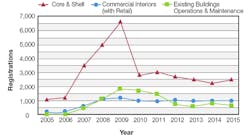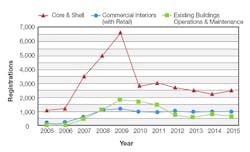The major green-building rating system in the United States, LEED, or Leadership in Energy & Environmental Design, is not growing. As of 2015, LEED’s 15th year, less than 1 percent of commercial buildings and homes in the United States were LEED-certified. Meanwhile, annual project registrations in the United States for LEED were fewer in 2015 than in 2010 (Figure 1). Following the December 2015 Paris climate-change agreement, a new way to rate buildings according to climate and environmental impact is needed.
Concerns about LEED are not new, but they have taken on more urgency with the mandatory switch to a new version of LEED (LEED v4) in October 2016. That LEED is in need of repair is not news; Randy Udall and Auden Schendler raised the issue in 2005 with the essay “LEED Is Broken-Let’s Fix It.” At the time, many LEED advocates, myself included, dismissed issues raised by the essay as growing pains for the LEED system. After all, in 2005, LEED was barely 5 years old and just getting started on the road to dominating the U.S. market for commercial green buildings.
But Udall and Schendler’s five main objections—LEED is too costly, project teams are focused more on gaining points than on results, LEED’s energy modeling is fiendishly difficult, LEED’s bureaucracy is crippling, and LEED’s advocates continually produce overblown benefit claims—remain drawbacks.
While most experienced green-building professionals still see these as issues, there is a bigger problem: Green-building rating systems have diverged greatly from building owners’ and operators’ core concerns, as they are designed to meet the needs more of green idealists than of market participants. As a result, interest in and use of LEED has diminished.
Green-building advocates need to abandon their approach of the last 25 years, characteristics of which include comprehensive and overly technical criteria, multiple elaborate rating systems, large and cumbersome bureaucracies, high costs, and inadequate focus on real long-term building performance.
The central thesis of my forthcoming book is that it is time for a serious debate about LEED’s (and other systems’) inadequacies in addressing global climate change, looming water shortages, and resource waste.
In my view, until we build new buildings and retrofit existing ones according to dramatically higher standards for (absolute, not relative) energy and water use, (absolute) carbon emissions, waste generation, and recycling, all other “green” considerations are mere window dressing.
Dubbed “The Godfather of Green” by WIRED magazine, Jerry Yudelson was named to the original class of 34 LEED Fellows and in 2014 and 2015 served as president of the Green Building Initiative. He is the author of 14 books on green building, including “Reinventing Green Building: Why Certification Systems Aren’t Cutting Enough Carbon and What We Can Do About It” (New Society Publishers, 2016).
Did you find this article useful? Send comments and suggestions to Executive Editor Scott Arnold at [email protected].










